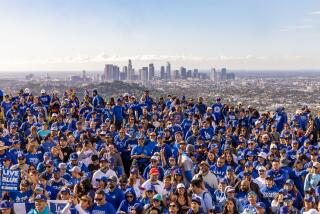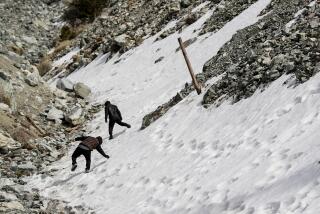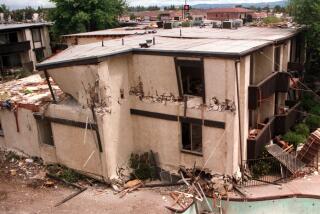Admirers of environmentalist seek a monument 14,242 feet high
Mountaineers worldwide consider it the zenith of the Sierra, 14,242 feet of vertigo-inducing walls and saw-toothed ridgelines, the loftiest in a cluster of peaks that guard the eastern flank of Kings Canyon National Park.
North Palisade, they will tell you, is to California what the Matterhorn is to the Alps: an international icon, a force of nature that dwarfs any man.
Unless that man is David Brower, say those who want to rename the peak for the renowned environmentalist.
Brower, who died in 2000 at 88, was among the most influential environmentalists of the last half century, an indefatigable visionary who articulated a populist view of man’s relationship with nature that reshaped American culture.
As the Sierra Club’s first executive director, Brower transformed what was an adult version of the Boy Scouts into a well-funded national political force. He fought dams that would have flooded the Grand Canyon and Dinosaur National Monument. He advocated for wilderness on dozens of fronts, including what became Redwood National Park and Point Reyes National Seashore.
Uncompromising and combative, he split with the Sierra Club several times and formed new organizations, Friends of the Earth and the Earth Island Institute.
Brower was also an accomplished mountaineer and was one of a small clique of men who explored California’s rooftop in the early 20th century. He pioneered a route up North Palisade and made the first winter ascent.
So when some of Brower’s friends were mulling ways to honor him, they hit on what seemed like a logical idea: Why not name the mountain after him?
“North Palisade, if not his favorite peak, was certainly one of them,” said John de Graaf, a Seattle author and filmmaker who made a documentary and wrote a children’s book about Brower. He fondly recalls climbing North Palisade as a teenager and seeing Brower’s signature in the summit register. “Ansel Adams and John Muir have peaks named after them. We want David Brower to be honored in a similar, significant way.”
In July, De Graaf and others persuaded U.S. Sens. Dianne Feinstein and Barbara Boxer to introduce a bill to change the name of North Palisade to Brower Palisade.
But as word spread through the tradition-bound community of Sierra mountaineers, it was received like a falling rock to the forehead.
“It’s one of California’s 14ers, so it’s a landmark!” said an incredulous Kastle Lund, who owns a climbing supply store in Lone Pine. “It’s, like, why don’t you just call it Staples Peak! . . . We here on the Eastern Sierra sure need the money.”
What’s in a name? Certainly not as much as there used to be. Only the most idealistic aren’t hardened to the way cash trumps tradition in professional and college sports. (Does anyone really call them the Los Angeles Angels of Anaheim?) Corporate logos are swapped out atop skyscrapers. Cultural venues are named after the most generous benefactor. A venture capitalist recently bought the naming rights to a bathroombathroom at the University of Colorado for $25,000.
Natural landmarks are a different story. Since 1890 the obscure U.S. Board on Geographic Names has been charged with maintaining a standardized nomenclature of place names used by the federal government. Every peak, island, gulch, lake, river, pass, hollow, swamp and ditch falls under its jurisdiction.
The board’s guidelines are voluminous and fastidious. Name changes are discouraged -- especially those of high mountain peaks. Preference is given to “present-day local usage whenever possible.”
“Place names are a very emotional issue to people. Changing them doesn’t feel right,” said Lou Yost, the board’s executive secretary. “The bigger the feature, the bigger the emotion. Mountains really bring this out in people.”
Only Congress can supersede the board’s authority, but it rarely does. And that is where the Brower Palisade bill, which remains in a Senate committee, gets knotty.
The small towns of the Eastern Sierra have long had their destinies shaped by outsiders -- from Los Angeles’ infamous Owens Valley water grab a century ago to more recent battles over wilderness protection of surrounding federal land.
So having two U.S. senators who live in the Bay Area sponsor a measure spearheaded by supporters of a lifelong Berkeley resident -- suffice to say it hasn’t gone down well on the more politically conservative side of the mountains.
“It’s like a slap in the face,” said Inyo County Supervisor Jim Bilyeu, who calls the Sierra Club an “elitist” organization and maintains he didn’t know who Brower was until North Palisade’s identity was threatened. “Somebody obviously thinks he’s a pretty important guy.”
Bilyeu drafted a resolution opposing the name change, which his colleagues endorsed. “Don’t you think they should at least have some public hearings?”
De Graaf said supporters expected the reaction and it’s one reason they are looking to Congress. But he was surprised by the sharp rebuke from mountaineers, who he reasoned would embrace honoring one of their own.
The Committee for Brower Palisade includes several prominent mountaineers -- among them Yvon Chouinard, founder of the Patagonia outdoor clothing company, and author Steve Roper. But the board of the state’s largest climbing club turned its collective thumbs down.
“I’ve received many e-mails from members and all of them said, ‘David Brower was an excellent climber and he should be recognized -- with some unnamed peak,’ ” said Virgil Popescu, chairman of the Sierra Peaks section of the Sierra Club’s Angeles chapter.
Online climbing chat rooms are full of disdain from regular Joe Chalk-Sacks.
“I’m a nobody. I just climb rocks,” said Rick Poedtke, a 49-year-old climber who retired to Crowley Lake after a Navy career. “The way they’re doing this is dirty. It was a sneak attack, and I’m going to give them a frontal attack.”
Poedtke has become a nettlesome pebble in the boot of the Brower Palisade effort, whipping up opposition at the website www.summitpost.org and organizing petitions against the Senate measure. The pugnacious Poedtke likens stripping North Palisade of its name to re-christening the aircraft carrier USS Enterprise, on which he served.
You just don’t do it.
“The Navy taught me that whenever you see something that’s wrong, it’s your duty to make it right. I’m known to stir up the pot,” said Poedtke, whose online moniker is “The Chief.” “If David Brower were alive, he’d be fighting this. It’s ego to me. Is that what David Brower stood for?”
In the days when the West seemed infinite, the names bestowed on mountains were as impermanent as rainbows. Indian monikers were changed by the Spanish, which were changed by American explorers and changed again by miners and settlers. Mountains were named for those who first ascended them, for politicians and Army officers, influential men and people who have vanished into the anonymity of history.
North Palisade, California’s fourth highest mountain, was mapped and named in 1864 by a party of Josiah Whitney’s first California Geological Survey. It was renamed Dusy’s Peak in 1879 for Frank Dusy, a rancher and early Sierra photographer who explored the Palisade region while moving his stock. Sixteen years later, it was changed to honor David Starr Jordan, Stanford University’s first president.
When Jordan was given another mountain, it went back to Dusy until 1903, when Joseph N. LeConte, son of a geologist and Sierra Club co-founder, and two others scaled the peak for the first time. LeConte was awe-struck.
“I have called the peak merely the North Palisade,” he wrote to an admirer of Dusy. “Put Dusy’s name on some less imposing mass, and give us a name to be handed down through all time.”
In the decades to come, North Palisade would become a crucible for the nascent sport of mountaineering in America, a place where techniques and equipment were invented and reputations made. A handful of men operated in this rarefied air: Norman Clyde and Jules Eichorn, Francis Farquhar, Ansel Adams and Glen Dawson among them. Many were Renaissance men who pursued writing, art and philosophy when they weren’t challenging nature.
“What alluring siren awaits the devoted mountaineer at the summit, what spirit lifts him to such heights?” asked a Los Angeles Times writer in a 1934 story headlined “These Strange Peak-Grabbers.” “While we remain encased in the mortar of the city, walled in on every side, others more sensitive to their relationship with nature seek contact with her at every opportunity.”
Brower was a student of these adventurers. In 1933, a 21-year-old Brower set his sights on the summit of a jagged peak in the Palisades range called the Thumb.
He scurried up a gorge on the mountain’s northwest face. His fingertips and feet found purchase in the granite’s crevices.
Then, in an instant, Brower found himself literally staring into the abyss.
“I got a fairly good handhold . . . on a rock that was good, it seemed to me,” Brower recalled in an oral history archived at UC Berkeley. “Then I put a knee on to scramble up higher and the whole thing came out.”
The slab rocketed past Brower and exploded below. “I reached up frantically with my left hand and with two fingers caught a little ledge . . . and hung by that and pulled myself on up. . . . I moved more carefully up to the ridge and sat down to collect myself.”
Later that day, Brower met Clyde and had dinner with California’s most famous mountaineer.
“I described my encounter, my close call, and he described to me the necessity of relying upon three-point suspension. If you were in anything that was difficult or exposed, then you moved only one limb at a time, with the other three staying in good solid places,” Brower recalled. “I tried that soon after on the North Palisade . . . [and] felt secure on it because I minded what Norman Clyde had said.”
Barbara Brower recalls her father’s affinity for North Palisade. As a professor of geography at Portland State University in Oregon, Brower, 58, brings a nuanced perspective to the name-change controversy.
“Place names have a reality that extend beyond themselves,” she said. They get ensconced in collective memory and are not easily dislodged. Grove Street in her native Berkeley was changed to Martin Luther King Boulevard, but “I still think of it as Grove Street,” she said.
Brower’s daughter was initially skeptical of changing North Palisade. “I had a hard time with it at first,” she said. “I do think it’s presumptuous to take a peak that’s been known for years by one name and slap somebody else’s name on it.”
But she has since concluded the switch would draw attention to environmental issues, including the continued shrinkage of Palisade Glacier, the Sierra’s largest, because of climate change. Besides, she adds, replacing the word “North” with the word “Brower” maintains the historic name “Palisade.”
“He needs a cool peak,” Barbara Brower said. “He was a cool guy.”
Glen Dawson agrees about Brower the man. But Brower the mountain leaves him conflicted for reasons that dwarf any peak.
Dawson, 96, is the patriarch of Sierra mountaineering, perhaps the last living link to a time when climbers were as rare as astronauts are today. He was in the first party to scale the east face of Mt. Whitney in 1931. He still has his lifetime Sierra Club membership -- No. 14, dated Oct. 31, 1921. A photo of him at age 16 hangs in his Pasadena apartment. It was taken by his friend Ansel Adams. Each has a Sierra mountain named after him.
Dawson is hard of hearing but the retired rare book dealer’s mind is sharp as an ice ax. He is 5 feet, 4 inches tall with hunched shoulders, wizened eyes and large ears. He could stand in for Yoda.
He and Brower climbed together, then fought in World War II as members of the famed 10th Mountain Division. Brower was his superior and blocked Dawson’s transfer to an Army depot from which soldiers were plucked to replace heavy casualties in the fiercest battlefronts -- a sure death sentence.
So although Dawson believes North Palisade should remain as is, he chooses his words carefully. He knows his opinion carries weight among climbers who revere him as a legend. He also firmly believes Brower saved his life.
“I feel a certain personal debt to David Brower. I’m not going to take a [public] position,” he said. “But I am puzzled: Of all the peaks out there, why did they choose North Palisade?”
Anton is a Times staff writer.
latimes.com /columnone Previous Column One articles are available online.
More to Read
Start your day right
Sign up for Essential California for news, features and recommendations from the L.A. Times and beyond in your inbox six days a week.
You may occasionally receive promotional content from the Los Angeles Times.






